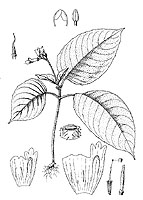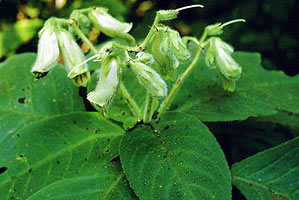

Left: Ying
T.S. et al., The endemic seed plants in China, Fig. 119 (1993); with permission.
Right: Li Z.Y &
Wang Y.Z., Plants of Gesneriaceae in China, Fig. 1.106 (2004); with permission.
Full name and orig. publication: Metabriggsia W.T.Wang, Guihaia 3: 1 (March 1983).
Etymology: Composed of the Greek prefix μετα-, meta = with, between, amid, after, and the generic name Briggsia. The name indicates the similarity with that genus, from which it differs by having only two fertile stamens and one carpel being sterile.
Infrafamilial position: Didymocarpoid Gesneriaceae - "Advanced Asiatic and Malesian genera" (Weber 2004).
Description: Perennial caulescent herbs. Stem erect, villose. Leaves opposite, petiolate, ovate or elliptic. Cymes axillary, pedunculate, few-flowered, bracteoles 2, forming a globose involucre. Sepals free, linear-lanceolate. Corolla white, funnel-shaped, bilabiate, upper lip short, shallowly 2-lobed, lower lip with 3 rounded lobes. Stamens 2; filaments inserted at middle of corolla tube, filiform, straight; anthers basifixed, apically coherent, locules not confluent; staminodes 2 or 3. Nectary annular. Ovary slender cylindrical, puberulous, only one carpel fertile, style slender, longer than ovary; stigma small, capitate. Capsule slender cylindrical.
Chromosome number: Unknown.
Species number: 2 [M. ovalifolia W.T.Wang, M. pupureotincta W.T.Wang].
Species names (incl. publication and synonyms): See Skog, L.E. & J.K. Boggan. 2005: World checklist of Gesneriaceae: http://persoon.si.edu/Gesneriaceae/Checklist.
Type species: Metabriggsia ovalifolia W.T.Wang
Distribution: S China (NW Guangxi).
Ecology: Growing in dense forests on limestone mountains; c. 1000m.
Notes: Probably allied to Briggsia, but diandrous and ovary with only one carpel fertile.
Selected references: Wang et al. in Wu & Raven (eds.), Fl. China 18: 293-294 (1998).
Bibliography: See Skog, L.E. & J.K. Boggan. 2005. Bibliography of the Gesneriaceae. 2nd edition: http://persoon.si.edu/Gesneriaceae/Bibliography.
Illustrations:
last modified: 2007-07-13